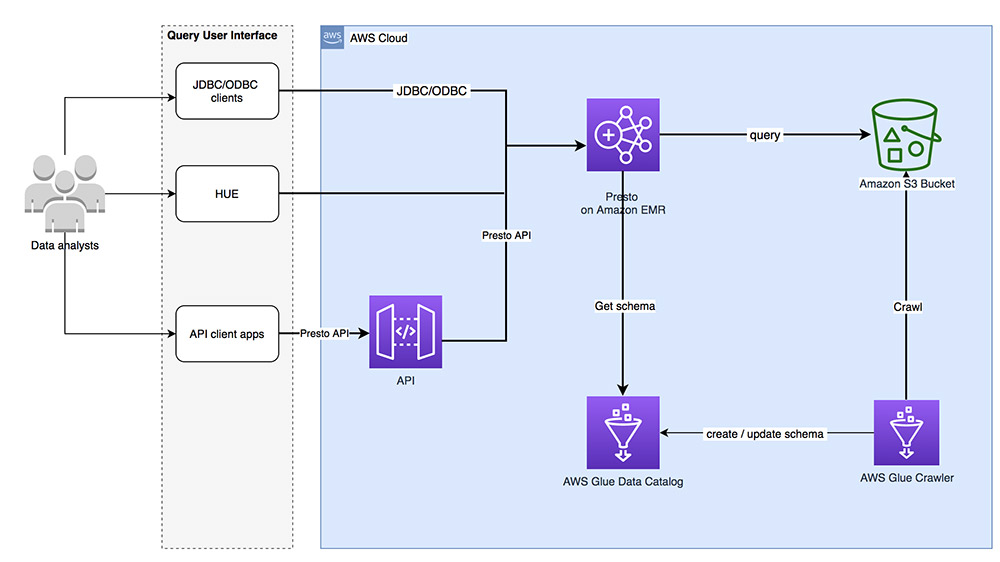AWS Big Data Blog
Category: Amazon EMR
Run a Spark SQL-based ETL pipeline with Amazon EMR on Amazon EKS
Increasingly, a business’s success depends on its agility in transforming data into actionable insights, which requires efficient and automated data processes. In the previous post – Build a SQL-based ETL pipeline with Apache Spark on Amazon EKS, we described a common productivity issue in a modern data architecture. To address the challenge, we demonstrated how to utilize a declarative approach as the key enabler to improve efficiency, which resulted in a faster time to value for businesses. Generally speaking, managing applications declaratively in Kubernetes is a widely adopted best practice. You can use the same approach to build and deploy Spark applications with open-source or in-house build frameworks to achieve the same productivity goal.
Visualize data using Apache Spark running on Amazon EMR with Amazon QuickSight
Organizations often need to process large volumes of data before serving to business stakeholders. In this blog, we will learn how to leverage Amazon EMR to process data using Apache Spark, the go-to platform for in-memory analytics of large data volume, and connect business intelligence (BI) tool Amazon QuickSight to serve data to end-users. QuickSight […]
Improve query performance using AWS Glue partition indexes
While creating data lakes on the cloud, the data catalog is crucial to centralize metadata and make the data visible, searchable, and queryable for users. With the recent exponential growth of data volume, it becomes much more important to optimize data layout and maintain the metadata on cloud storage to keep the value of data […]
Manage and process your big data workflows with Amazon MWAA and Amazon EMR on Amazon EKS
Many customers are gathering large amount of data, generated from different sources such as IoT devices, clickstream events from websites, and more. To efficiently extract insights from the data, you have to perform various transformations and apply different business logic on your data. These processes require complex workflow management to schedule jobs and manage dependencies […]
Amazon EMR introduces EMR runtime for Presto, providing a 2.6 times speedup
Presto is an open-source distributed SQL query engine for running interactive analytic queries against data sources of all sizes ranging from gigabytes to petabytes. Presto was designed and written from the ground up for interactive analytics, and approaches the speed of commercial data warehouses while scaling to the size of organizations like Facebook. Running Presto […]
Amazon EMR announces general availability of EMR Studio
At AWS re:Invent 2020, we announced the preview of Amazon EMR Studio, an integrated development environment (IDE) that makes it easy for data scientists and data engineers to develop, visualize, and debug applications written in R, Python, Scala, and PySpark. Today, we’re excited to announce the general availability of EMR Studio and new features we’ve […]
Build Slowly Changing Dimensions Type 2 (SCD2) with Apache Spark and Apache Hudi on Amazon EMR
April 2024: This post was reviewed for accuracy. Organizations across the globe are striving to improve the scalability and cost efficiency of the data warehouse. Offloading data and data processing from a data warehouse to a data lake empowers companies to introduce new use cases like ad hoc data analysis and AI and machine learning […]
Orchestrate an Amazon EMR on Amazon EKS Spark job with AWS Step Functions
At re:Invent 2020, we announced the general availability of Amazon EMR on Amazon EKS, a new deployment option for Amazon EMR that allows you to automate the provisioning and management of open-source big data frameworks on Amazon Elastic Kubernetes Service (Amazon EKS). With Amazon EMR on EKS, you can now run Spark applications alongside other […]
Amazon EMR 6.2.0 adds persistent HFile tracking to improve performance with HBase on Amazon S3
Apache HBase is an open-source, NoSQL database that you can use to achieve low latency random access to billions of rows. Starting with Amazon EMR 5.2.0, you can enable HBase on Amazon Simple Storage Service (Amazon S3). With HBase on Amazon S3, the HBase data files (HFiles) are written to Amazon S3, enabling data lake […]
Top 9 performance tuning tips for PrestoDB on Amazon EMR
Presto is a popular distributed SQL query engine for interactive data analytics. With its massively parallel processing (MPP) architecture, it’s capable of directly querying large datasets without the need of time-consuming and costly ETL processes. With a properly tuned Presto cluster you can run fast queries against big data with response times ranging from subsecond […]






